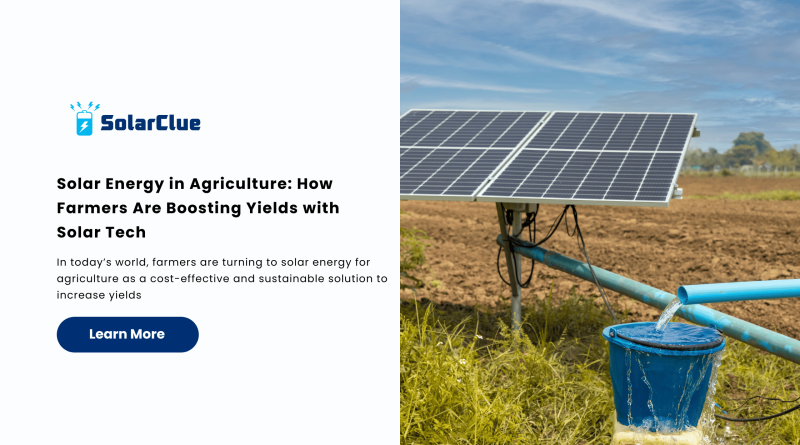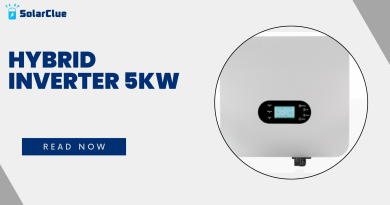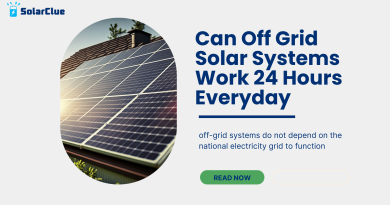Solar Energy in Agriculture: How Farmers Are Boosting Yields with Solar Tech
In today’s world, farmers are turning to solar energy for agriculture as a cost-effective and sustainable solution to increase yields while reducing expenses. The adoption of solar power systems for agriculture is helping farmers cut electricity costs and improve efficiency. With rising concerns about energy prices and environmental impact, the use of solar farming technology has become a game-changer. From solar-powered irrigation systems to solar energy for greenhouses, farmers are now leveraging the power of the sun to boost productivity and profitability. But how does solar power truly benefit agriculture? Let’s explore.
Table of Contents
- 1 Understanding Solar Energy and Agriculture
- 2 How Solar Panels Help Farmers Save Money
- 3 The Best Solar Solutions for Agriculture
- 4 Installation of Solar Power Plants on Farms
- 5 Solar Energy for Greenhouses and Precision Farming
- 6 The Future of Solar Energy in Agriculture
- 7 Conclusion – Why Farmers Should Switch to Solar
- 8 FAQs
- 8.1 1. How much does a solar power system for agriculture cost?
- 8.2 2. Can solar panels work for large-scale farms?
- 8.3 3. What is the best solar irrigation system for small farmers?
- 8.4 4. How long does it take to recover the investment in solar energy for agriculture?
- 8.5 5. Are there any government subsidies for farmers installing solar power?
Understanding Solar Energy and Agriculture
The integration of solar energy and agriculture is reshaping traditional farming methods. Solar power works by capturing sunlight and converting it into electricity, which can be used to power irrigation systems, machinery, and even greenhouses. Farmers investing in solar panels ensure a stable power supply while reducing dependency on the grid. Additionally, the installation of a solar power plant on farmland enables farmers to generate their own energy, reducing operational costs. The key benefits of using renewable energy in agriculture include lower expenses, reduced carbon footprint, and enhanced efficiency.
How Solar Panels Help Farmers Save Money
Switching to solar power can significantly reduce farmers’ electricity bills. By utilizing solar panels, farmers can generate their own energy, decreasing their reliance on costly fossil fuels. Here’s how solar energy for agriculture contributes to cost savings:
1. Lower electricity costs – Farmers using solar farming technology pay less for energy compared to those relying solely on the grid.
2. Government incentives – Many countries offer solar energy subsidies for farmers, making it more affordable to adopt solar solutions.
3. Increased profits – Reducing electricity costs allows farmers to reinvest in their businesses, increasing overall productivity.
Many farmers have seen a dramatic drop in expenses after installing solar power systems for agriculture, making it one of the best investments in modern farming.
The Best Solar Solutions for Agriculture
Farmers have several solar-powered farming solutions at their disposal. Here are the most effective ones:
1. Solar-Powered Irrigation Systems
One of the most revolutionary applications of solar energy for agriculture is in irrigation. Solar irrigation systems eliminate the need for expensive diesel pumps by providing a renewable and sustainable water supply.
2. Solar Water Pumps for Agriculture
A solar-powered irrigation system ensures that crops receive adequate water without relying on electricity from the grid. This makes solar water pumps for agriculture highly beneficial in remote areas with limited access to conventional power sources.
3. Solar-Powered Drip Irrigation
By combining solar-powered irrigation with drip irrigation, farmers can optimize water usage while reducing energy consumption. This method is particularly effective for water-scarce regions, making solar-powered drip irrigation a must-have for sustainable farming.
Installation of Solar Power Plants on Farms
For farmers looking to fully transition to solar power, setting up a solar power system for agriculture is the way forward. Here’s a step-by-step guide on how to install solar panels on a farm:
1. Assess Energy Needs – Determine how much electricity your farm requires.
2. Choose the Right Solar Panels – Select panels based on efficiency and solar panel price considerations.
3. Secure Government Incentives – Apply for solar energy subsidies for farmers to reduce installation costs.
4. Install the System – Work with professionals for the installation of a solar power plant on your farm.
5. Maintain & Monitor – Regular maintenance ensures longevity and optimal performance.
Solar Energy for Greenhouses and Precision Farming
The use of solar energy for greenhouses is another innovative approach that’s gaining popularity. By using solar farming technology, farmers can regulate temperature, automate irrigation, and enhance plant growth.
Precision farming, combined with solar power, allows farmers to utilize smart sensors and AI-driven analytics to optimize crop yields. As technology advances, solar-powered farming is becoming the future of agriculture.
The Future of Solar Energy in Agriculture
With the increasing focus on sustainability, solar energy and agriculture will continue to evolve. The adoption of solar power is expected to grow, with more innovations in solar irrigation systems, battery storage, and automated farming solutions.
Governments worldwide are also promoting renewable energy in agriculture by offering incentives and subsidies. As energy costs continue to rise, farmers who invest in solar farming technology today will reap long-term benefits.
Conclusion – Why Farmers Should Switch to Solar
The advantages of solar energy for agriculture are undeniable. From cutting costs to improving sustainability, solar power systems for agriculture provide an efficient and eco-friendly way to enhance farm productivity. Whether it’s using solar-powered irrigation systems, setting up solar energy for greenhouses, or investing in a solar water pump for agriculture, farmers have countless opportunities to harness the sun’s power.
By making the switch to solar power, farmers can secure a sustainable and profitable future for their farms. Interested in learning more? Visit our website today and explore the best solar solutions for agriculture!
FAQs
1. How much does a solar power system for agriculture cost?
The solar panel price varies based on size and type, but with solar energy subsidies for farmers, the costs are significantly reduced.
2. Can solar panels work for large-scale farms?
Yes! Large farms can benefit from solar farming technology, including solar-powered irrigation systems and energy storage solutions.
3. What is the best solar irrigation system for small farmers?
For small farms, solar-powered drip irrigation and solar water pumps for agriculture are cost-effective and efficient.
4. How long does it take to recover the investment in solar energy for agriculture?
Most farmers recover their investment in solar power within 3-7 years, depending on incentives and electricity savings.
5. Are there any government subsidies for farmers installing solar power?
Yes! Many governments offer solar energy subsidies for farmers, making it easier to adopt solar-powered farming solutions.



